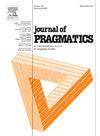The beauty of communication. Corpus analysis of adverb categories in comments on communication activities in Polish (in light of comparative data from other languages)
IF 1.7
1区 文学
0 LANGUAGE & LINGUISTICS
引用次数: 0
Abstract
Currently, linguistic studies on (im)politeness from a first-order perspective constitute a fruitful alternative to classical second-order perspective attempts. However, information about (im)politeness is not solely derived from first-order perspective reports on interactions. Thus, the main purpose of this research was to discover the variety of adverbs that express assessments of both behavior in general and particular communication activities in first-order perspective reports, as well as to attempt a semantic typology of these adverbs, considered in the background of comparative data from other languages. Therefore, the study utilized two corpora of Polish: the National Corpus of Polish (NKJP) and the Corpus of Narration about Communication (KNOK).
As a result, the analysis of the NKJP corpus showed that the adverbs co-occurring with the verb zachow(yw)ać się jakośi as its semantic complement form a set of diverse meanings. The semantic analysis enabled the assignment of each adverb to one of 18 semantic categories.
Moreover, the KNOK corpus analysis indicated that the adverbs ładnie, pięknie, and elegancko, which imply esthetic evaluation, were dominant in interaction reports. They were used together twice as often as the adverb grzecznie, which implies politeness. Additionally, overall, adverbs indicating the speaker's positive attitude toward the observed actions had a higher frequency than those indicating negative evaluation.
In conclusion, it was found that Polish language users tend to evaluate communicative activities in esthetic categories. This tendency was also observed in the Slovenian corpus but not in the English and Dutch corpora, suggesting that it may be specific to Slavic languages.
沟通之美。波兰语交际活动评论中副词类别的语料库分析(结合其他语言的比较数据)
目前,从一阶角度对礼貌进行的语言学研究是对经典二阶视角尝试的有效替代。然而,关于(im)礼貌的信息并不仅仅来源于对互动的一阶视角报告。因此,本研究的主要目的是发现在一阶视角报告中表达对一般和特定交际活动行为评估的各种副词,并在其他语言比较数据的背景下尝试对这些副词进行语义类型学研究。因此,本研究使用了两个波兰语语料库:国家波兰语语料库(NKJP)和关于交流的叙述语料库(KNOK)。因此,对NKJP语料库的分析表明,与动词“zachow(yw)”和“azi siojakośi”作为语义补语共现的副词构成了一组不同的意义。语义分析可以将每个副词分配到18个语义类别中的一个。此外,KNOK语料库分析表明,暗示审美评价的副词ładnie、pięknie和elegancko在交互报告中占主导地位。它们一起使用的频率是副词grzecznie的两倍,后者表示礼貌。此外,总体而言,表明说话人对观察到的行为持积极态度的副词比表明消极评价的副词使用频率更高。综上所述,我们发现波兰语使用者倾向于用审美范畴来评价交际活动。在斯洛文尼亚语料库中也观察到这种趋势,但在英语和荷兰语语料库中却没有,这表明这可能是斯拉夫语言特有的。
本文章由计算机程序翻译,如有差异,请以英文原文为准。
求助全文
约1分钟内获得全文
求助全文
来源期刊

Journal of Pragmatics
Multiple-
CiteScore
3.90
自引率
18.80%
发文量
219
期刊介绍:
Since 1977, the Journal of Pragmatics has provided a forum for bringing together a wide range of research in pragmatics, including cognitive pragmatics, corpus pragmatics, experimental pragmatics, historical pragmatics, interpersonal pragmatics, multimodal pragmatics, sociopragmatics, theoretical pragmatics and related fields. Our aim is to publish innovative pragmatic scholarship from all perspectives, which contributes to theories of how speakers produce and interpret language in different contexts drawing on attested data from a wide range of languages/cultures in different parts of the world. The Journal of Pragmatics also encourages work that uses attested language data to explore the relationship between pragmatics and neighbouring research areas such as semantics, discourse analysis, conversation analysis and ethnomethodology, interactional linguistics, sociolinguistics, linguistic anthropology, media studies, psychology, sociology, and the philosophy of language. Alongside full-length articles, discussion notes and book reviews, the journal welcomes proposals for high quality special issues in all areas of pragmatics which make a significant contribution to a topical or developing area at the cutting-edge of research.
 求助内容:
求助内容: 应助结果提醒方式:
应助结果提醒方式:


